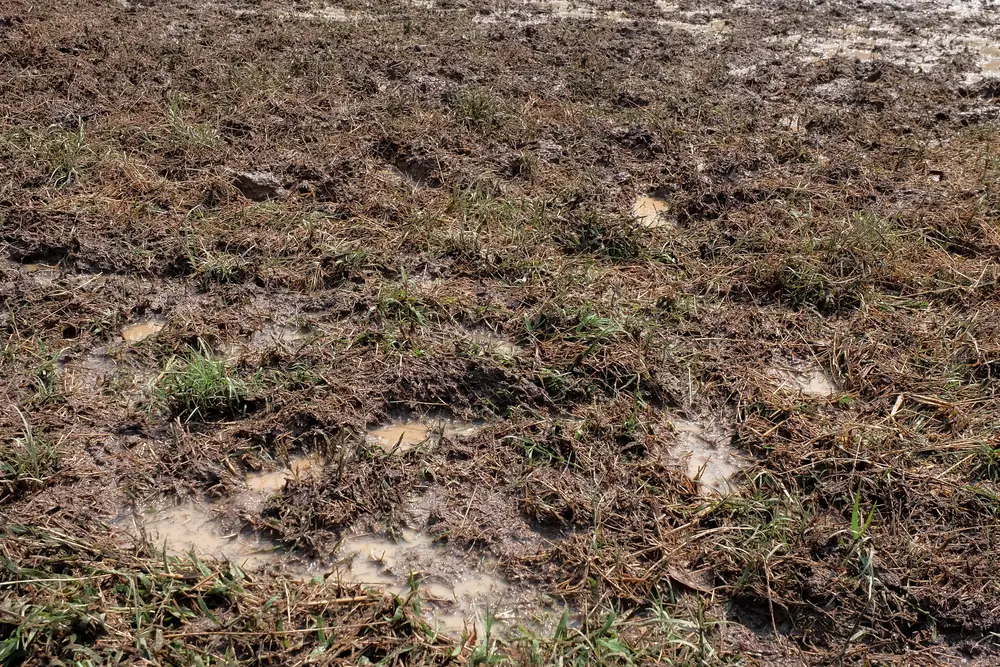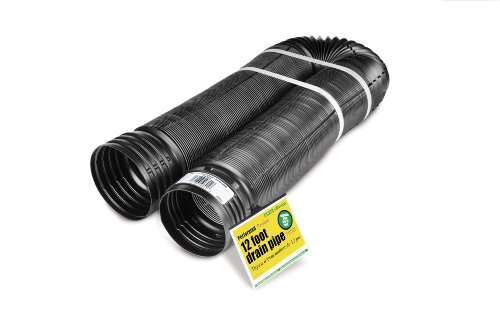If you care about your lawn as much as we do, there’s nothing more painful than a big muddy patch in the backyard. Not only is a mud pit unattractive, but it’s also messy, particularly if you have kids or dogs since children and animals seem to be attracted to mud like bees are to honey. Not to mention, it’s a nightmare for mowing. Thankfully, we’re here to help. Here, we’ll discuss how to cover up mud in the backyard.

Let’s get started!
Table of Contents
Improve Your Drainage
It doesn’t take a genius or a landscaping expert to tell you that water plus dirt equals mud. So, one possible method of eliminating backyard mud is to get rid of some of the water. There are several ways you can achieve this.
Install a Drainage Pipe
Perhaps the most effective method of improving your drainage is simply to divert the water to the edge of your property. To do this, you’ll either need to rent an excavator, or you’ll need a shovel, some elbow grease, and a lot of patience.
Starting just uphill of your muddy spot, dig a trench, heading in a downhill direction. The trench should be at least six inches wide because you’ll need to lay a four-inch drainage pipe inside. It should also be about a foot deep, although you’ll need to angle it downhill, so if you cut across a rise you’ll need to dig deeper to maintain a downward slope.
Once that’s done, you’ll need perforated pipe. Cap off the uphill end, and leave the downhill end open. Then, cover the entire trench and plant new grass over the top.
Before you try this, check your local laws regarding drainage. In some areas, drainage laws are regulated to prevent harmful chemical runoff.
- Pipe unfolds and expands from 15-inches to 12-feet
- Perforated pipe is for ground water drainage (French drains, dispersing water from flower beds) where soil is coarse
- Exceeds all applicable ASTM Standards
- Compatible with most traditional 3-inch and 4-inch corrugated pipe and 4-Inch PVC
- 30-Percent higher load-bearing rating than standard corrugated pipe
Last update on 2024-07-13 / Affiliate links / Images from Amazon Product Advertising API
Loosen Up Your Soil
Oftentimes, drainage problems are the result of compacted soil, which becomes too thick to properly absorb water. This doesn’t just cause mud, it can also make the soil too dense for roots to penetrate. In this case, the problem will get worse over time as more and more of your grass or ground cover dies off.
In this case, you’ll want to run a rototiller and churn up the soil down to at least a foot deep. Unless you’re using an industrial-sized tiller, this will mean making two or more passes.
Next, shovel out that soil and replace the lower few inches with peat moss. This material is far looser than dense dirt and will form an absorbent layer that keeps water from getting stuck in the top few inches of the soil. Shovel your dirt back into the area, and spread new sod or ground cover.
- [POWERFUL]: 13.5-Amp motor cultivates up to 16 in. Wide x 8 in. Deep
- [DURABLE]: 6 Steel angled tines for maximum durability and performance
- [EASY STORAGE]: Handle folds for convenient storage and easy transport
- [ADJUSTABLE]: 3-position wheel adjustment
- [WEVE GOT YOU COVERED!]: Your new tiller and cultivator is backed by the snow Joe and Sun Joe customer promise. We will warrant New, powered products for two years from the date of purchase. No questions asked. Contact snow Joe and Sun Joe customer Support at 1-866-766-9563 for further assistance.
Last update on 2024-07-13 / Affiliate links / Images from Amazon Product Advertising API
Dethatch Your Lawn
Dead grass, old clippings, and even decaying leaves can get tangled up under your grass, forming a matted layer that keeps water from draining. Over time, this can lead to muddy spots.
To prevent this, you’ll need to dethatch your lawn on a yearly basis. There are several dethatchers on the market that are designed to do exactly that.
These machines, often called power rakes, have a series of vertical tines that swing rapidly back and forth. This intense sweeping action pulls up matted, dead grass, and leaves it lying loosely on the top of the lawn.
Once you’ve finished running the dethatcher, you’ll need to follow up with a standard manual rake to collect all the debris. Otherwise, it will just get matted down again, wasting your time and effort.
For more tips and tricks to improve lawn drainage, read our handy guide to lawn drainage.
- KEEP YOUR YARD HEALTHY : dethatch in early spring or early fall for cool-season grasses, and in late spring through early summer (after the 2nd mowing) for warm-season grasses.Speed : 3700 RPM, Motor : 120 V, AC only, 60 Hz, 10 Amps
- POWERFUL MOTOR : 10A motor provides the power you need to tackle the toughest jobs
- 14” DETHATCHING PATH : allows you to complete jobs faster and more efficiently
- 3-POSITION HEIGHT ADJUST : provides greater control by removing matted layers to promote lawn health
- STAINLESS STEEL TINES : stays sharp longer for reliable performance
Last update on 2024-07-13 / Affiliate links / Images from Amazon Product Advertising API
Use the Water
There’s an old saying that goes: “if you can’t beat ‘em, join ‘em”. Similarly, if you live in a low-lying area – or if it just rains a lot in your location – drainage might not be possible. But there’s no reason you can’t put that water to better use. Here are a few ways to do that.
Plant Some Trees
Many homeowners prefer as few trees as possible. But the suburban American ideal of a perfect, all-grass lawn just isn’t realistic in many climates.
The reason for this is that, while grass requires constant watering in dry areas, it really doesn’t absorb that much water. Blades of grass are tiny, and even millions of blades of grass don’t have as much biomass as a tree.
Trees are very thirsty and will soak up large amounts of water after heavy rain. By planting a tree, or a row of trees, near your trouble spot, you can dry out your muddy spot in short order.
If you’re buying your trees from a landscaping company, be aware that the roots can sometimes become twisted inside the canvas bag they wrap the root ball in. If you just set the tree in the ground as it arrived, curved roots can strangle the tree trunks, which means that the tree will die after it’s grown for a few years.
To properly plant a tree, first, wash all the dirt off the root ball, and ensure that the roots are all pointed away from the trunk. And mix some peat moss in with the soil as you fill it in around the tree. This way, the tree will grow strong and healthy for many years to come.
Install a Rain Garden
Another way to use the runoff to your advantage is to install a rain garden in your muddy area. On the one hand, this means that part of your lawn won’t be useful for walking or playing backyard football. On the other hand, it also means you won’t have to plant any trees, so the rest of your lawn will still get plenty of sun.
The concept behind a rain garden is simple: plant a small patch of plants that love wet, soggy conditions. These plants will be different depending on your area, so check with your state’s Department of Conservation or your local equipment to find out which plants are ideal.
Typically, the best way to manage a rain garden is to plant several perennial species that flower at different times of the year. This way, you’ll only need to plant once, and there will always be flowers throughout the spring, summer, and fall.
If you’re going to go this route, make sure not to use a rubber landscape guard. The entire purpose of a rain garden is to provide a place for water to produce beautiful plants. A water barrier will defeat the purpose.
Cover it Up
If your house is located in a swampy area or the bottom of a valley, even a combination of drainage and water-loving plants may not be enough. If your basement floods every time it rains, you’re probably in one of these areas. In that case, the best solution is oftentimes to simply to cover up the mud.
Extend Your Deck or Porch
In the event that your muddy patch is right next to your deck, sometimes the easiest solution is simply to extend the deck past the trouble spot. Depending on the layout of your deck and the slope of your lawn, this may be something you can do yourself, or you may be better off hiring a professional.
If you’re going to do this, don’t use those cheap concrete footers that sit on top of the ground. In the mud and soft soil, they’re just going to sink, taking your deck along with them.
Take the time to dig below the frost line, and pour proper concrete footers. This is time-consuming, and it costs more than cheap footers, but it will ensure that your deck remains stable.
Install a Rock Garden
Of course, extending your deck only works if you have a deck to extend and if the trouble spot is nearby. If your mud patch is way out on the lawn, you’ll need a different solution.
When all else fails, your best bet may be to install a rock garden. Depending on how bad the mud is, you might need to install a porous retaining wall, in order to pile the rock up deep enough that the top layer is always above the water.
Conclusion
So, what’s the best way to cover up mud in the backyard?
As you can see, this entirely depends on what’s causing the problem. So your first step is to identify the source of the problem.
As we’ve mentioned, it’s easy to tell whether you have a drainage problem that can be solved. If your lawn is only wet in one area, or if your lawn is on a slope, drainage is generally to blame.
On the other hand, if all the surrounding lawns are also soggy, drainage isn’t going to do you much good. There’s nowhere for the water to go! In that case, you’ll need to either use the water, soak it up, or cover it up.
No matter what your solution, we hope we helped point you in the right direction. Now all you have to do is get outside and start landscaping!



